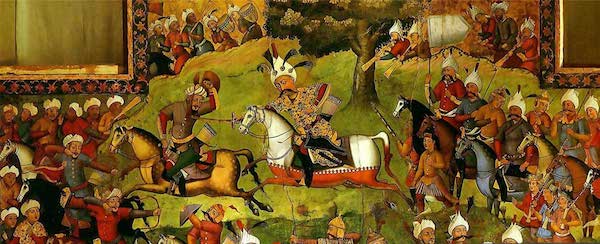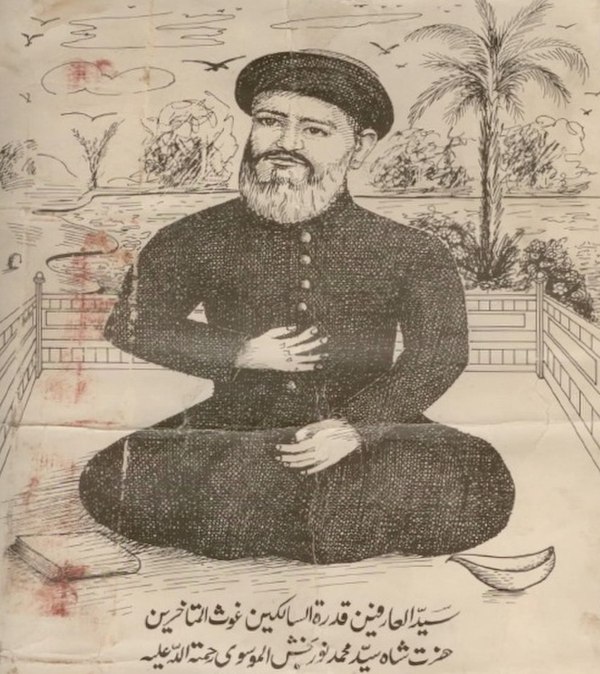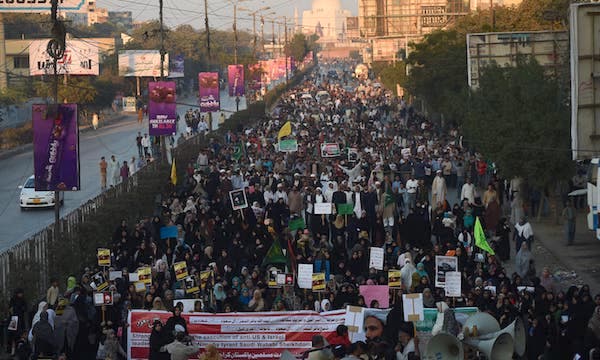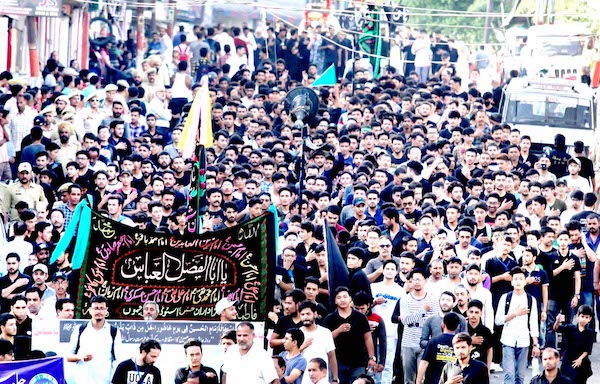The Shia of Kashmir have a unique history. There were two groups of Shias who migrated to Kashmir from present day Iran and Iraq in the fifteenth and sixteenth centuries. One group escaped persecution and the other were missionaries. Some artisan classes also joined these groups. Local conversion due to efforts of missionaries increased Shia numbers. In Gilgit-Baltistan area with geographic links to Badakhshan province of Afghanistan and Tajikistan, Ismaili missionaries were successful in small pockets while mainstream Ath’na Asha’ari (followers of twelve Imams) missionaries were successful in areas that are now part of Indian Controlled Kashmir (ICK). The separation of Gilgit-Baltistan from Pakistan Controlled Kashmir (PCK) which is ethnically and linguistically different from Kashmiris has left no significant Shia population in PCK.
In ICK there are about one million Shia out of a total Muslim population of 8.5 million and they are geographically and politically separated. Sparsely populated Ladakh which is now separated from Jammu & Kashmir (J&K) as Union Territory has equal numbers of Buddhists and Muslims. In the Kargil area, ninety percent of the Muslim population is Shia numbering about 125’000. There are small numbers of Sunnis in the Drass area. The remainder Shia population is concentrated in the Valley.
Many missionaries and Sufi orders of Shia and Sunni branches made Kashmir their home. Like other Muslims of India, Pakistan and Bangladesh, the Shia of Kashmir also claim foreign ancestry. This genetic pride of belonging to a ‘blue blood’ lineage has an undercurrent tone of avoiding the stigma of conversion from local low-caste Hindus. They add to their names the name of the city from where their ancestors may or may not have migrated. Hamadani, Kirmani, Shirazi, Qazvini, Isfahani, etc are common last names used by Kashmiri Shia. Socially, the Shia society is divided along elites consisting of clerics and landed aristocracy and artisan classes. Politically, there are few Shia families competing for influence within the community and then projecting this influence to claim larger share in state’s political and economic fortunes. This struggle for power inevitably results in fractures within dominant families.

For over a century, two families i.e. Safavi and Ansari have been competing for religious and political leadership of the community in the Valley. In view of claim over religious leadership and role in running Sharia courts, both families gradually degenerated into cults or sub-sects. This had long term negative fallout for the Shia community. The Safavi or Agha family are Syeds and descendants of an Iranian Sufi saint. The seat of the Safavi family is in Budgam. The most influential head was Agha Syed Yusuf al-Mosavi al-Safavi who died in 1982. After Yusuf’s death, the family was divided over the issue of a successor. Yusuf’s son Agha Syed Muhammad Fazlullah (1947-2018) and nephew Agha Syed Mustafa al-Mosavi al-Safavi (1918-2002) ran parallel organizations including separate Sharia courts. The battle invariably spread to the political arena as local and national political parties cultivated prominent family members for political clout. The Indian Congress backed Mustafa while the National Conference (NC) backed Fazlullah. The family lost significant influence due to split as well as political somersaults of prominent members of the family for personal gains. Fazlullah left the political arena to his brother Mahmud. After twice serving minister in the NC government, he joined the rival People’s Democratic party (PDP). Later, when he was denied a ticket by PDP he came back to NC. Mustafa’s two sons played the same game. Agha Syed Hassan unsuccessfully contested elections on the ticket of Janata Party, the forerunner of the Bhartiya Janata Party (BJP) and later joined the separatist All Parties Hurriyat Conference (APHC). His brother Agha Syed Mehdi (1959-2000) joined Congress but never won elections. He was killed by militants in 2000. His young son Ruhullah was promptly recruited by NC and he served as minister in Omar Abdullah’s cabinet. Ruhullah was married to his cousin and daughter of Hassan. In 2015, relations between the two deteriorated after Ruhullah divorced his wife and reached such a point where Hassan did not allow Ruhullah to observe the death anniversary of his father in the family Imambargah; the fear of violence forced the government to impose significant restrictions around family properties.
The Ansari family of Srinagar traces its origin to an Iranian scholar Mullah Alam Ansari who migrated to Kashmir. The family continued the tradition of engaging in the theological arena and members of the family are usually alumni of Shia learning centers of Najaf in Iraq. The Ansaris were well off from their land holdings and held control of lucrative endowments and major Imambargahs (Shia houses of mourning). This family split on the death of Maulvi Muhammad Jawad in 1957. Influential members of the family supported his son Maulvi Iftikhar Hussain Ansari (1942-2014) while a smaller group followed his cousin Maulvi Muhammad Abbas Ansari (1938-). Iftikhar held all the family’s fortunes and religious mantle. The political wing Shia Association supported Shaikh Abdullah’s rival Bakhshi Ghulam Muhammad during Shaikh Abdullah’s estrangement from Nehru and imprisonment. Later Iftikhar joined NC and when it was ousted from power, he joined PDP. Abbas having a weaker hand on religious, political and economic fronts joined Shaikh Abdullah’s plebiscite plank but didn’t get along when later became Chief Minister. He formed Anjuman-e-Ittihad-e-Muslimeen (Society for Unity of Muslims) and supported the separatist APHC. He became chairman of APHC in 2003 but when he advocated negotiations with Delhi he was ousted and replaced by Syed Ali Geelani.

The Shias of Kargil have a unique history. In the fifteenth century, disciples of Shia Sufi Syed Muhammad Nurbakhsh (1392-1464) travelled from Khorasan and via Baltistan came to Kargil. Many local followers of Tibetan Buddhism converted to the Nurbakhshi order. A century later, they converted to Ath’na Asha’ari creed from missionary works of disciples of Mir Shamsuddin Muhammad Araki (1440-1515). In 1947 with the division of Kashmir, a large Shia population consisting of Ath’na Asha’ari, Nurbakhshi and Ismaili Shia concentrated in the northern areas of Gilgit and Baltistan came under Pakistani control. Traditionally, the clerical establishment organized under the banner of Anjuman-e-Jamiat-ul-Ulama Asna Asharia (Society of Clerics of Twelve Imamers) of Kargil, popularly known as the Islamia school. This body of orthodox clerics controlled religious and political aspects of the community and had links with the Shia learning centers of Najaf and Karbala in Iraq. The Najafi House in Mumbai coordinates between the clerics of Najaf and the Indian Shia. After expulsion of foreign clerics from Iraq under Saddam Hussain, many students from Kargil moved to Qum and Mashhad in Iran.
After the Iranian revolution in 1979, a new wave swept among the younger generation of Shia of Kargil. This group consisted of young members from lower socio-economic ladders of the society. They were influenced by the writings of ideologues of Iranian revolution especially Ayatollah Murtaza Motaharri (1919-1979). This breakaway group from the Islamia School established Imam Khomeini Memorial Trust (IKMT). The Iranian Cultural Center in Delhi is the link between Qum based clerics and the Indian Shia. These two groups now compete for community’s religious and political support. The Islamia School uses photographs and posters of Iraq based Ayatollah Ali Sistani (1930-) while the IKMT displays Iranian clerics Ayatollah Ruhollah Khomeini (1902-1989) and Ayatollah Ali Hussain Khamenei (1939).
The Iranian government as well as religious establishments based in Qum and Iraq have links with the Shia power centers of Kashmir. The Iranian government has close economic and diplomatic relations with India and it is very careful when it comes to internal issues of India, especially Kashmir conflict. On the other hand, the office of Supreme Leader Ayatollah Khamenei does not have diplomatic restraint and needs to be cognizant of its sympathizers in foreign countries. Khamenei’s office have more influence among the Shia of Kashmir, especially in Kargil therefore his office has issued statements in support of Kashmir.
In the Valley, the Shia largely live in their own neighborhoods but they are socially, politically and economically linked with Sunnis (with increased insecurity, Shia from mixed neighborhoods have moved out creating a certain degree of ghettoization). They are also facing extreme insecurity like other inhabitants of the Valley with daily humiliation therefore resentment against India is strong. However, there are very few Shia who joined the armed struggle. In the 1990s, the rise of mostly foreign militants of more austere forms of Sunni Islam in Kashmir raised fear among Shia. This apprehension was due to fact of rising sectarianism in neighboring Pakistan where Shia were targets. Later, in competition with Iran, Saudi Arabia funded new mosques in India including Kashmir that propagated more austere version of Islam that is different from Sufi version prevalent in Kashmir. Indian security apparatus is apprehensive about this trend fearing that more extremist groups like Daesh may find fertile ground in these mosques (this problem is more serious in the southern states of Kerala and Karnataka). However, Indian political leadership is confident that strong economic and diplomatic relations with Saudi Arabia can be used to mitigate this threat. The Jury is still out on this strategy as small cells operating outside Kashmir can create havoc.
In Kargil, local dynamics is in competition with Buddhist half of the region and efforts are focused to increase Shia representation in political and economic hub of Ladakh. There is sympathy with Kashmir self-determination and the Shia of Kargil opposed separation of Ladakh from J&K and transition to a Union territory. However, being away from the most insecure areas and now more autonomy under Hill Councils, their political strategy is to increase participation in local politics and development projects. The Indian government will likely use these trends to keep the Shia of Kargil at least neutral and in conflict with Muslims of the Valley. However, several factors such as lower socio-economic status and more ideological bent towards Shia resistance models of Middle East make the Shia of Kargil a potential trouble spot.

The Shia of Kashmir are influenced by events in the broader Shia world. There have been protests in ICK when Pakistan arrested a Shia cleric in Gilgit and when Saudi Arabia executed dissident Shia cleric Shaikh Nimr al Nimr. Iran is using this influence for ideological reasons and rallying support of Shia outside Iran for its geo-political objectives. However, it is managing it under the banner of Muslim unity and strenuously avoids any criticism of the internal policies of Indian government related to Kashmir. On its part, the Indian government using its good relations with Iran, it will like to see this influence being used to keep the Shia of Kashmir neutral in the separatist conflict. However, being a minority, the Shia of Kashmir need a balancing act to avoid the charge of being traitors to the separatist cause.
In the last three decades, a new generation of Shia is influenced by Shia resistance literature. Iranian and Lebanese resistance literature is translated and has become very popular among the young Shia of Kashmir. The essential element is the doctrine of Khamenei dividing the world into two groups; mustazaf’een (oppressed) and istikhbar’een (oppressors). This has powerful resonance among Shia and rise of power of Shia militias operating in Lebanon, Yemen, Iraq and Syria has made deep impact on Shia all over the world including Kashmir. There have been reports of some Kashmiri Shias being trained by Iran and Hezbollah for fighting in Iraq and Syria. The young generation of Shia are angry at their own corrupt elite and influenced by the resistance Shia models of Middle East. If this trend gains momentum, then some Shia youth may drift towards armed struggle.
The Shia of Kashmir are a minority within a minority. The Shia leadership is walking a fine line. The grievances of Kashmiris are also grievances of the Shia and the leadership of various groups needs to express this view. However, on the other hand, they don’t want to cross a certain line that can seriously jeopardize the physical, social and economic health of their community.
Notes:
Radhika Gupta. Experiments with Khomeini’s Revolution in Kargil: Contemporary Shi’a networks between India and West India. Modern Asian Studies, March 2014, Volume: 48, Issue: 2. Pp. 370-398.
Parvez Alam. The Spread of Shi’ism in Kashmir during Chak Dynasty 1554-1586. Islam and Modern Studies, 2015
Sajjad Haider. Shias of Kashmir: Socio-political Dilemmas. Kashmir Observer
Abhinav Pandya. Iran and Saudi Arabia’s Proxy Wars have a new battlefield: Indian Controlled Kashmir. Haaretz, 21 July 2019
Hamid Hussain. The Wild Card – Shias of Iraq. Defence Journal, August 2003, Volume: 7, No. 1.
Cole, J. R. I. Roots of North Indian Shi’ism in Iran and Iraq: Religion and State in Awadh, 1722-1859. Berkeley: University of California Press, 1988.




